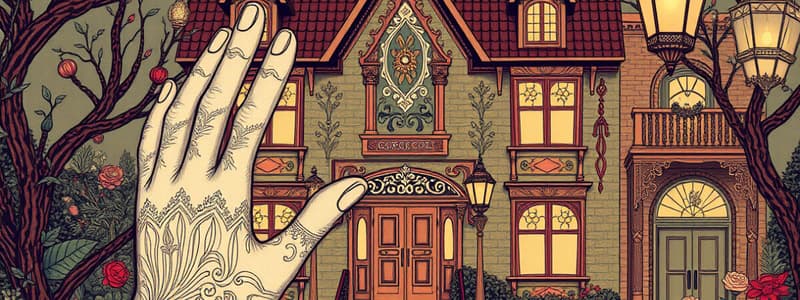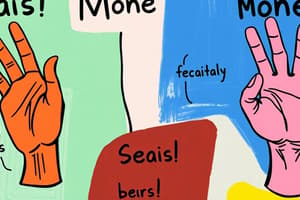Podcast
Questions and Answers
What is the term for a location with many businesses operating?
What is the term for a location with many businesses operating?
- Residential area
- Business area (correct)
- Industrial area
- Rural area
Which area is primarily used for housing?
Which area is primarily used for housing?
- Industrial area
- Rural area
- Residential area (correct)
- Commercial area
What type of area is characterized by low population density and open space?
What type of area is characterized by low population density and open space?
- Mansion area
- Rural area (correct)
- Condo area
- Business area
What is a common type of housing that is a single unit?
What is a common type of housing that is a single unit?
Which term refers to a large area often used for artistic work?
Which term refers to a large area often used for artistic work?
What is the term for a marketplace where local farmers sell their products?
What is the term for a marketplace where local farmers sell their products?
What does 'blue collar' refer to?
What does 'blue collar' refer to?
What does 'safe' mean in the context of an area?
What does 'safe' mean in the context of an area?
What is the opposite of a 'quiet' area?
What is the opposite of a 'quiet' area?
Define 'a lot of foot traffic'.
Define 'a lot of foot traffic'.
What does 'few' mean?
What does 'few' mean?
Flashcards are hidden until you start studying
Study Notes
Neighborhood Vocabulary
- Business Area: Sections of a community designated for commercial activities and offices.
- Industrial Area: Zones primarily occupied by factories and manufacturing facilities.
- Residential Area: Regions primarily composed of housing where people live.
- Rural Area: Locations characterized by open space, agricultural land, and sparse population density.
- Country Area: Similar to rural areas, typically encompasses natural landscapes and smaller communities.
Types of Housing
- Apartment: A single unit in a multi-family building providing living space.
- Loft: An open living space typically converted from industrial or commercial buildings featuring high ceilings and large windows.
- Condo: A privately owned unit within a shared building or complex, usually part of a homeowners' association.
Neighborhood Characteristics
- Newer Neighborhood: Areas that have developed recently often featuring modern amenities and homes.
- Older Neighborhood: Established regions typically featuring historical architecture and longer-standing community.
- Mansions: Large, luxurious homes often associated with wealth and high status.
Spatial Terms
- Near: Close in proximity; a relative position descriptor.
- Across from: Located directly opposite; a spatial relation between two points.
- Behind: Positioned at the back of something; indicates relative location.
- On the right side/next to: Indicates location to the right of a reference point.
- On the left side/next to: Indicates location to the left of a reference point.
Neighborhood Qualities
- Quiet, Tranquil: Areas that are peaceful, ideal for relaxation.
- Noisy, Not Quiet: Regions with significant sound, often associated with high activity levels.
- Safe: Environments indicating low crime rates and secure surroundings.
- Neat, Clean: Well-maintained areas reflecting order and cleanliness.
Activity Levels
- A lot of foot traffic: High levels of pedestrian activity indicating a busy area.
- Empty streets: Indicate low activity and possibly a lack of commerce.
- Unsafe, Dangerous: Areas perceived with high risks or crime levels.
- Filthy, Dirty: Locations with poor sanitation and hygiene conditions.
- Stinky, Smelly: Areas with unpleasant odors, often due to waste or pollution.
- Boring: Places lacking attractions or entertainment.
- Lots of things to do, high level of activity: Vibrant areas with various entertainment and engagement opportunities.
Timeframe Terms
- Many years ago, long time ago: Referring to events or conditions from the distant past.
- Up until now: Emphasizing a continuous state or condition up to the present time.
Economic Terms
- Cheap: Inexpensive goods or living conditions.
- Expensive: High-cost items or housing, often indicating wealth or luxury.
- Most: Referring to the majority within a category.
- Some: Indicating a portion that is not the majority or all.
- Few: Denotes a small number, indicating scarcity.
Key Concepts
- Neighborhood: A community characterized by social interaction, shared services, and common identities among residents.
- Move-Away: The act of relocating from one neighborhood to another.
- Diverse: Reflects varied demographics and cultures within a neighborhood.
- Area: General term indicating a specific section of land or community.
- Woods: Natural forested areas within or adjacent to neighborhoods, often offering recreational space.
- Mansion: Large, opulent residences typically signifying wealth and status.
Studying That Suits You
Use AI to generate personalized quizzes and flashcards to suit your learning preferences.




